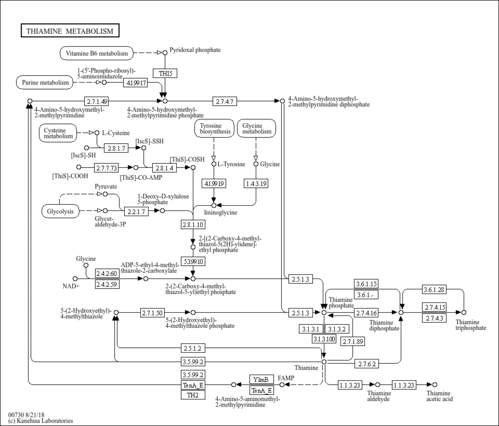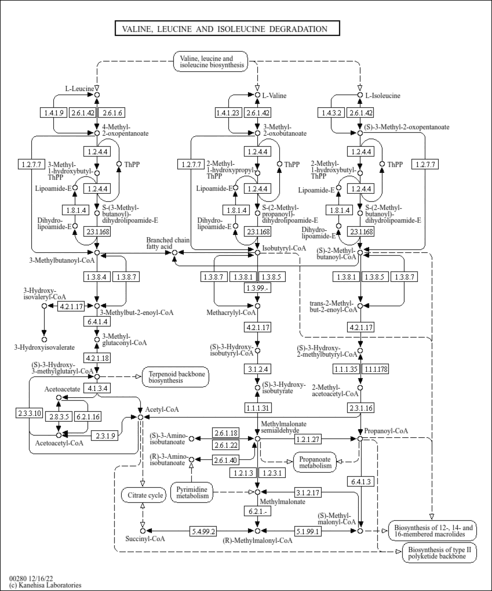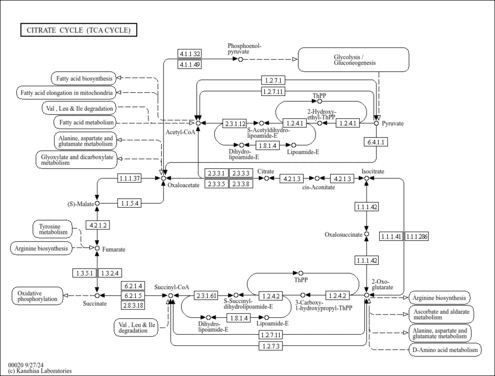| Thiamine pyrophosphate,1TMS,isomer #1 | CC1=NC=C(C[N+]2=CSC(CCOP(=O)(O[Si](C)(C)C)OP(=O)(O)O)=C2C)C(N)=N1 | 3503.0 | Semi standard non polar | 33892256 |
| Thiamine pyrophosphate,1TMS,isomer #1 | CC1=NC=C(C[N+]2=CSC(CCOP(=O)(O[Si](C)(C)C)OP(=O)(O)O)=C2C)C(N)=N1 | 3175.9 | Standard non polar | 33892256 |
| Thiamine pyrophosphate,1TMS,isomer #1 | CC1=NC=C(C[N+]2=CSC(CCOP(=O)(O[Si](C)(C)C)OP(=O)(O)O)=C2C)C(N)=N1 | 5436.9 | Standard polar | 33892256 |
| Thiamine pyrophosphate,1TMS,isomer #2 | CC1=NC=C(C[N+]2=CSC(CCOP(=O)(O)OP(=O)(O)O[Si](C)(C)C)=C2C)C(N)=N1 | 3473.5 | Semi standard non polar | 33892256 |
| Thiamine pyrophosphate,1TMS,isomer #2 | CC1=NC=C(C[N+]2=CSC(CCOP(=O)(O)OP(=O)(O)O[Si](C)(C)C)=C2C)C(N)=N1 | 3183.1 | Standard non polar | 33892256 |
| Thiamine pyrophosphate,1TMS,isomer #2 | CC1=NC=C(C[N+]2=CSC(CCOP(=O)(O)OP(=O)(O)O[Si](C)(C)C)=C2C)C(N)=N1 | 5440.4 | Standard polar | 33892256 |
| Thiamine pyrophosphate,1TMS,isomer #3 | CC1=NC=C(C[N+]2=CSC(CCOP(=O)(O)OP(=O)(O)O)=C2C)C(N[Si](C)(C)C)=N1 | 3545.2 | Semi standard non polar | 33892256 |
| Thiamine pyrophosphate,1TMS,isomer #3 | CC1=NC=C(C[N+]2=CSC(CCOP(=O)(O)OP(=O)(O)O)=C2C)C(N[Si](C)(C)C)=N1 | 3132.4 | Standard non polar | 33892256 |
| Thiamine pyrophosphate,1TMS,isomer #3 | CC1=NC=C(C[N+]2=CSC(CCOP(=O)(O)OP(=O)(O)O)=C2C)C(N[Si](C)(C)C)=N1 | 5580.9 | Standard polar | 33892256 |
| Thiamine pyrophosphate,2TMS,isomer #1 | CC1=NC=C(C[N+]2=CSC(CCOP(=O)(O[Si](C)(C)C)OP(=O)(O)O[Si](C)(C)C)=C2C)C(N)=N1 | 3448.3 | Semi standard non polar | 33892256 |
| Thiamine pyrophosphate,2TMS,isomer #1 | CC1=NC=C(C[N+]2=CSC(CCOP(=O)(O[Si](C)(C)C)OP(=O)(O)O[Si](C)(C)C)=C2C)C(N)=N1 | 3261.7 | Standard non polar | 33892256 |
| Thiamine pyrophosphate,2TMS,isomer #1 | CC1=NC=C(C[N+]2=CSC(CCOP(=O)(O[Si](C)(C)C)OP(=O)(O)O[Si](C)(C)C)=C2C)C(N)=N1 | 4938.9 | Standard polar | 33892256 |
| Thiamine pyrophosphate,2TMS,isomer #2 | CC1=NC=C(C[N+]2=CSC(CCOP(=O)(O[Si](C)(C)C)OP(=O)(O)O)=C2C)C(N[Si](C)(C)C)=N1 | 3491.8 | Semi standard non polar | 33892256 |
| Thiamine pyrophosphate,2TMS,isomer #2 | CC1=NC=C(C[N+]2=CSC(CCOP(=O)(O[Si](C)(C)C)OP(=O)(O)O)=C2C)C(N[Si](C)(C)C)=N1 | 3221.0 | Standard non polar | 33892256 |
| Thiamine pyrophosphate,2TMS,isomer #2 | CC1=NC=C(C[N+]2=CSC(CCOP(=O)(O[Si](C)(C)C)OP(=O)(O)O)=C2C)C(N[Si](C)(C)C)=N1 | 4922.4 | Standard polar | 33892256 |
| Thiamine pyrophosphate,2TMS,isomer #3 | CC1=NC=C(C[N+]2=CSC(CCOP(=O)(O)OP(=O)(O[Si](C)(C)C)O[Si](C)(C)C)=C2C)C(N)=N1 | 3450.9 | Semi standard non polar | 33892256 |
| Thiamine pyrophosphate,2TMS,isomer #3 | CC1=NC=C(C[N+]2=CSC(CCOP(=O)(O)OP(=O)(O[Si](C)(C)C)O[Si](C)(C)C)=C2C)C(N)=N1 | 3248.6 | Standard non polar | 33892256 |
| Thiamine pyrophosphate,2TMS,isomer #3 | CC1=NC=C(C[N+]2=CSC(CCOP(=O)(O)OP(=O)(O[Si](C)(C)C)O[Si](C)(C)C)=C2C)C(N)=N1 | 5009.9 | Standard polar | 33892256 |
| Thiamine pyrophosphate,2TMS,isomer #4 | CC1=NC=C(C[N+]2=CSC(CCOP(=O)(O)OP(=O)(O)O[Si](C)(C)C)=C2C)C(N[Si](C)(C)C)=N1 | 3475.6 | Semi standard non polar | 33892256 |
| Thiamine pyrophosphate,2TMS,isomer #4 | CC1=NC=C(C[N+]2=CSC(CCOP(=O)(O)OP(=O)(O)O[Si](C)(C)C)=C2C)C(N[Si](C)(C)C)=N1 | 3215.5 | Standard non polar | 33892256 |
| Thiamine pyrophosphate,2TMS,isomer #4 | CC1=NC=C(C[N+]2=CSC(CCOP(=O)(O)OP(=O)(O)O[Si](C)(C)C)=C2C)C(N[Si](C)(C)C)=N1 | 4982.7 | Standard polar | 33892256 |
| Thiamine pyrophosphate,2TMS,isomer #5 | CC1=NC=C(C[N+]2=CSC(CCOP(=O)(O)OP(=O)(O)O)=C2C)C(N([Si](C)(C)C)[Si](C)(C)C)=N1 | 3481.8 | Semi standard non polar | 33892256 |
| Thiamine pyrophosphate,2TMS,isomer #5 | CC1=NC=C(C[N+]2=CSC(CCOP(=O)(O)OP(=O)(O)O)=C2C)C(N([Si](C)(C)C)[Si](C)(C)C)=N1 | 3273.0 | Standard non polar | 33892256 |
| Thiamine pyrophosphate,2TMS,isomer #5 | CC1=NC=C(C[N+]2=CSC(CCOP(=O)(O)OP(=O)(O)O)=C2C)C(N([Si](C)(C)C)[Si](C)(C)C)=N1 | 5171.3 | Standard polar | 33892256 |
| Thiamine pyrophosphate,3TMS,isomer #1 | CC1=NC=C(C[N+]2=CSC(CCOP(=O)(O[Si](C)(C)C)OP(=O)(O[Si](C)(C)C)O[Si](C)(C)C)=C2C)C(N)=N1 | 3454.0 | Semi standard non polar | 33892256 |
| Thiamine pyrophosphate,3TMS,isomer #1 | CC1=NC=C(C[N+]2=CSC(CCOP(=O)(O[Si](C)(C)C)OP(=O)(O[Si](C)(C)C)O[Si](C)(C)C)=C2C)C(N)=N1 | 3266.2 | Standard non polar | 33892256 |
| Thiamine pyrophosphate,3TMS,isomer #1 | CC1=NC=C(C[N+]2=CSC(CCOP(=O)(O[Si](C)(C)C)OP(=O)(O[Si](C)(C)C)O[Si](C)(C)C)=C2C)C(N)=N1 | 4610.5 | Standard polar | 33892256 |
| Thiamine pyrophosphate,3TMS,isomer #2 | CC1=NC=C(C[N+]2=CSC(CCOP(=O)(O[Si](C)(C)C)OP(=O)(O)O[Si](C)(C)C)=C2C)C(N[Si](C)(C)C)=N1 | 3485.2 | Semi standard non polar | 33892256 |
| Thiamine pyrophosphate,3TMS,isomer #2 | CC1=NC=C(C[N+]2=CSC(CCOP(=O)(O[Si](C)(C)C)OP(=O)(O)O[Si](C)(C)C)=C2C)C(N[Si](C)(C)C)=N1 | 3272.1 | Standard non polar | 33892256 |
| Thiamine pyrophosphate,3TMS,isomer #2 | CC1=NC=C(C[N+]2=CSC(CCOP(=O)(O[Si](C)(C)C)OP(=O)(O)O[Si](C)(C)C)=C2C)C(N[Si](C)(C)C)=N1 | 4506.9 | Standard polar | 33892256 |
| Thiamine pyrophosphate,3TMS,isomer #3 | CC1=NC=C(C[N+]2=CSC(CCOP(=O)(O[Si](C)(C)C)OP(=O)(O)O)=C2C)C(N([Si](C)(C)C)[Si](C)(C)C)=N1 | 3477.0 | Semi standard non polar | 33892256 |
| Thiamine pyrophosphate,3TMS,isomer #3 | CC1=NC=C(C[N+]2=CSC(CCOP(=O)(O[Si](C)(C)C)OP(=O)(O)O)=C2C)C(N([Si](C)(C)C)[Si](C)(C)C)=N1 | 3326.5 | Standard non polar | 33892256 |
| Thiamine pyrophosphate,3TMS,isomer #3 | CC1=NC=C(C[N+]2=CSC(CCOP(=O)(O[Si](C)(C)C)OP(=O)(O)O)=C2C)C(N([Si](C)(C)C)[Si](C)(C)C)=N1 | 4610.1 | Standard polar | 33892256 |
| Thiamine pyrophosphate,3TMS,isomer #4 | CC1=NC=C(C[N+]2=CSC(CCOP(=O)(O)OP(=O)(O[Si](C)(C)C)O[Si](C)(C)C)=C2C)C(N[Si](C)(C)C)=N1 | 3482.1 | Semi standard non polar | 33892256 |
| Thiamine pyrophosphate,3TMS,isomer #4 | CC1=NC=C(C[N+]2=CSC(CCOP(=O)(O)OP(=O)(O[Si](C)(C)C)O[Si](C)(C)C)=C2C)C(N[Si](C)(C)C)=N1 | 3262.6 | Standard non polar | 33892256 |
| Thiamine pyrophosphate,3TMS,isomer #4 | CC1=NC=C(C[N+]2=CSC(CCOP(=O)(O)OP(=O)(O[Si](C)(C)C)O[Si](C)(C)C)=C2C)C(N[Si](C)(C)C)=N1 | 4529.7 | Standard polar | 33892256 |
| Thiamine pyrophosphate,3TMS,isomer #5 | CC1=NC=C(C[N+]2=CSC(CCOP(=O)(O)OP(=O)(O)O[Si](C)(C)C)=C2C)C(N([Si](C)(C)C)[Si](C)(C)C)=N1 | 3463.1 | Semi standard non polar | 33892256 |
| Thiamine pyrophosphate,3TMS,isomer #5 | CC1=NC=C(C[N+]2=CSC(CCOP(=O)(O)OP(=O)(O)O[Si](C)(C)C)=C2C)C(N([Si](C)(C)C)[Si](C)(C)C)=N1 | 3312.6 | Standard non polar | 33892256 |
| Thiamine pyrophosphate,3TMS,isomer #5 | CC1=NC=C(C[N+]2=CSC(CCOP(=O)(O)OP(=O)(O)O[Si](C)(C)C)=C2C)C(N([Si](C)(C)C)[Si](C)(C)C)=N1 | 4683.2 | Standard polar | 33892256 |
| Thiamine pyrophosphate,4TMS,isomer #1 | CC1=NC=C(C[N+]2=CSC(CCOP(=O)(O[Si](C)(C)C)OP(=O)(O[Si](C)(C)C)O[Si](C)(C)C)=C2C)C(N[Si](C)(C)C)=N1 | 3513.2 | Semi standard non polar | 33892256 |
| Thiamine pyrophosphate,4TMS,isomer #1 | CC1=NC=C(C[N+]2=CSC(CCOP(=O)(O[Si](C)(C)C)OP(=O)(O[Si](C)(C)C)O[Si](C)(C)C)=C2C)C(N[Si](C)(C)C)=N1 | 3285.2 | Standard non polar | 33892256 |
| Thiamine pyrophosphate,4TMS,isomer #1 | CC1=NC=C(C[N+]2=CSC(CCOP(=O)(O[Si](C)(C)C)OP(=O)(O[Si](C)(C)C)O[Si](C)(C)C)=C2C)C(N[Si](C)(C)C)=N1 | 4088.4 | Standard polar | 33892256 |
| Thiamine pyrophosphate,4TMS,isomer #2 | CC1=NC=C(C[N+]2=CSC(CCOP(=O)(O[Si](C)(C)C)OP(=O)(O)O[Si](C)(C)C)=C2C)C(N([Si](C)(C)C)[Si](C)(C)C)=N1 | 3478.8 | Semi standard non polar | 33892256 |
| Thiamine pyrophosphate,4TMS,isomer #2 | CC1=NC=C(C[N+]2=CSC(CCOP(=O)(O[Si](C)(C)C)OP(=O)(O)O[Si](C)(C)C)=C2C)C(N([Si](C)(C)C)[Si](C)(C)C)=N1 | 3332.0 | Standard non polar | 33892256 |
| Thiamine pyrophosphate,4TMS,isomer #2 | CC1=NC=C(C[N+]2=CSC(CCOP(=O)(O[Si](C)(C)C)OP(=O)(O)O[Si](C)(C)C)=C2C)C(N([Si](C)(C)C)[Si](C)(C)C)=N1 | 4223.5 | Standard polar | 33892256 |
| Thiamine pyrophosphate,4TMS,isomer #3 | CC1=NC=C(C[N+]2=CSC(CCOP(=O)(O)OP(=O)(O[Si](C)(C)C)O[Si](C)(C)C)=C2C)C(N([Si](C)(C)C)[Si](C)(C)C)=N1 | 3479.3 | Semi standard non polar | 33892256 |
| Thiamine pyrophosphate,4TMS,isomer #3 | CC1=NC=C(C[N+]2=CSC(CCOP(=O)(O)OP(=O)(O[Si](C)(C)C)O[Si](C)(C)C)=C2C)C(N([Si](C)(C)C)[Si](C)(C)C)=N1 | 3324.3 | Standard non polar | 33892256 |
| Thiamine pyrophosphate,4TMS,isomer #3 | CC1=NC=C(C[N+]2=CSC(CCOP(=O)(O)OP(=O)(O[Si](C)(C)C)O[Si](C)(C)C)=C2C)C(N([Si](C)(C)C)[Si](C)(C)C)=N1 | 4224.2 | Standard polar | 33892256 |
| Thiamine pyrophosphate,5TMS,isomer #1 | CC1=NC=C(C[N+]2=CSC(CCOP(=O)(O[Si](C)(C)C)OP(=O)(O[Si](C)(C)C)O[Si](C)(C)C)=C2C)C(N([Si](C)(C)C)[Si](C)(C)C)=N1 | 3504.4 | Semi standard non polar | 33892256 |
| Thiamine pyrophosphate,5TMS,isomer #1 | CC1=NC=C(C[N+]2=CSC(CCOP(=O)(O[Si](C)(C)C)OP(=O)(O[Si](C)(C)C)O[Si](C)(C)C)=C2C)C(N([Si](C)(C)C)[Si](C)(C)C)=N1 | 3319.7 | Standard non polar | 33892256 |
| Thiamine pyrophosphate,5TMS,isomer #1 | CC1=NC=C(C[N+]2=CSC(CCOP(=O)(O[Si](C)(C)C)OP(=O)(O[Si](C)(C)C)O[Si](C)(C)C)=C2C)C(N([Si](C)(C)C)[Si](C)(C)C)=N1 | 3837.3 | Standard polar | 33892256 |
| Thiamine pyrophosphate,1TBDMS,isomer #1 | CC1=NC=C(C[N+]2=CSC(CCOP(=O)(O[Si](C)(C)C(C)(C)C)OP(=O)(O)O)=C2C)C(N)=N1 | 3736.9 | Semi standard non polar | 33892256 |
| Thiamine pyrophosphate,1TBDMS,isomer #1 | CC1=NC=C(C[N+]2=CSC(CCOP(=O)(O[Si](C)(C)C(C)(C)C)OP(=O)(O)O)=C2C)C(N)=N1 | 3366.3 | Standard non polar | 33892256 |
| Thiamine pyrophosphate,1TBDMS,isomer #1 | CC1=NC=C(C[N+]2=CSC(CCOP(=O)(O[Si](C)(C)C(C)(C)C)OP(=O)(O)O)=C2C)C(N)=N1 | 5511.0 | Standard polar | 33892256 |
| Thiamine pyrophosphate,1TBDMS,isomer #2 | CC1=NC=C(C[N+]2=CSC(CCOP(=O)(O)OP(=O)(O)O[Si](C)(C)C(C)(C)C)=C2C)C(N)=N1 | 3717.0 | Semi standard non polar | 33892256 |
| Thiamine pyrophosphate,1TBDMS,isomer #2 | CC1=NC=C(C[N+]2=CSC(CCOP(=O)(O)OP(=O)(O)O[Si](C)(C)C(C)(C)C)=C2C)C(N)=N1 | 3374.5 | Standard non polar | 33892256 |
| Thiamine pyrophosphate,1TBDMS,isomer #2 | CC1=NC=C(C[N+]2=CSC(CCOP(=O)(O)OP(=O)(O)O[Si](C)(C)C(C)(C)C)=C2C)C(N)=N1 | 5512.0 | Standard polar | 33892256 |
| Thiamine pyrophosphate,1TBDMS,isomer #3 | CC1=NC=C(C[N+]2=CSC(CCOP(=O)(O)OP(=O)(O)O)=C2C)C(N[Si](C)(C)C(C)(C)C)=N1 | 3753.6 | Semi standard non polar | 33892256 |
| Thiamine pyrophosphate,1TBDMS,isomer #3 | CC1=NC=C(C[N+]2=CSC(CCOP(=O)(O)OP(=O)(O)O)=C2C)C(N[Si](C)(C)C(C)(C)C)=N1 | 3320.7 | Standard non polar | 33892256 |
| Thiamine pyrophosphate,1TBDMS,isomer #3 | CC1=NC=C(C[N+]2=CSC(CCOP(=O)(O)OP(=O)(O)O)=C2C)C(N[Si](C)(C)C(C)(C)C)=N1 | 5517.7 | Standard polar | 33892256 |
| Thiamine pyrophosphate,2TBDMS,isomer #1 | CC1=NC=C(C[N+]2=CSC(CCOP(=O)(O[Si](C)(C)C(C)(C)C)OP(=O)(O)O[Si](C)(C)C(C)(C)C)=C2C)C(N)=N1 | 3885.9 | Semi standard non polar | 33892256 |
| Thiamine pyrophosphate,2TBDMS,isomer #1 | CC1=NC=C(C[N+]2=CSC(CCOP(=O)(O[Si](C)(C)C(C)(C)C)OP(=O)(O)O[Si](C)(C)C(C)(C)C)=C2C)C(N)=N1 | 3589.6 | Standard non polar | 33892256 |
| Thiamine pyrophosphate,2TBDMS,isomer #1 | CC1=NC=C(C[N+]2=CSC(CCOP(=O)(O[Si](C)(C)C(C)(C)C)OP(=O)(O)O[Si](C)(C)C(C)(C)C)=C2C)C(N)=N1 | 5068.7 | Standard polar | 33892256 |
| Thiamine pyrophosphate,2TBDMS,isomer #2 | CC1=NC=C(C[N+]2=CSC(CCOP(=O)(O[Si](C)(C)C(C)(C)C)OP(=O)(O)O)=C2C)C(N[Si](C)(C)C(C)(C)C)=N1 | 3917.6 | Semi standard non polar | 33892256 |
| Thiamine pyrophosphate,2TBDMS,isomer #2 | CC1=NC=C(C[N+]2=CSC(CCOP(=O)(O[Si](C)(C)C(C)(C)C)OP(=O)(O)O)=C2C)C(N[Si](C)(C)C(C)(C)C)=N1 | 3560.9 | Standard non polar | 33892256 |
| Thiamine pyrophosphate,2TBDMS,isomer #2 | CC1=NC=C(C[N+]2=CSC(CCOP(=O)(O[Si](C)(C)C(C)(C)C)OP(=O)(O)O)=C2C)C(N[Si](C)(C)C(C)(C)C)=N1 | 5029.9 | Standard polar | 33892256 |
| Thiamine pyrophosphate,2TBDMS,isomer #3 | CC1=NC=C(C[N+]2=CSC(CCOP(=O)(O)OP(=O)(O[Si](C)(C)C(C)(C)C)O[Si](C)(C)C(C)(C)C)=C2C)C(N)=N1 | 3892.3 | Semi standard non polar | 33892256 |
| Thiamine pyrophosphate,2TBDMS,isomer #3 | CC1=NC=C(C[N+]2=CSC(CCOP(=O)(O)OP(=O)(O[Si](C)(C)C(C)(C)C)O[Si](C)(C)C(C)(C)C)=C2C)C(N)=N1 | 3570.3 | Standard non polar | 33892256 |
| Thiamine pyrophosphate,2TBDMS,isomer #3 | CC1=NC=C(C[N+]2=CSC(CCOP(=O)(O)OP(=O)(O[Si](C)(C)C(C)(C)C)O[Si](C)(C)C(C)(C)C)=C2C)C(N)=N1 | 5136.8 | Standard polar | 33892256 |
| Thiamine pyrophosphate,2TBDMS,isomer #4 | CC1=NC=C(C[N+]2=CSC(CCOP(=O)(O)OP(=O)(O)O[Si](C)(C)C(C)(C)C)=C2C)C(N[Si](C)(C)C(C)(C)C)=N1 | 3898.2 | Semi standard non polar | 33892256 |
| Thiamine pyrophosphate,2TBDMS,isomer #4 | CC1=NC=C(C[N+]2=CSC(CCOP(=O)(O)OP(=O)(O)O[Si](C)(C)C(C)(C)C)=C2C)C(N[Si](C)(C)C(C)(C)C)=N1 | 3564.3 | Standard non polar | 33892256 |
| Thiamine pyrophosphate,2TBDMS,isomer #4 | CC1=NC=C(C[N+]2=CSC(CCOP(=O)(O)OP(=O)(O)O[Si](C)(C)C(C)(C)C)=C2C)C(N[Si](C)(C)C(C)(C)C)=N1 | 5084.8 | Standard polar | 33892256 |
| Thiamine pyrophosphate,2TBDMS,isomer #5 | CC1=NC=C(C[N+]2=CSC(CCOP(=O)(O)OP(=O)(O)O)=C2C)C(N([Si](C)(C)C(C)(C)C)[Si](C)(C)C(C)(C)C)=N1 | 3907.4 | Semi standard non polar | 33892256 |
| Thiamine pyrophosphate,2TBDMS,isomer #5 | CC1=NC=C(C[N+]2=CSC(CCOP(=O)(O)OP(=O)(O)O)=C2C)C(N([Si](C)(C)C(C)(C)C)[Si](C)(C)C(C)(C)C)=N1 | 3623.4 | Standard non polar | 33892256 |
| Thiamine pyrophosphate,2TBDMS,isomer #5 | CC1=NC=C(C[N+]2=CSC(CCOP(=O)(O)OP(=O)(O)O)=C2C)C(N([Si](C)(C)C(C)(C)C)[Si](C)(C)C(C)(C)C)=N1 | 5165.0 | Standard polar | 33892256 |
| Thiamine pyrophosphate,3TBDMS,isomer #1 | CC1=NC=C(C[N+]2=CSC(CCOP(=O)(O[Si](C)(C)C(C)(C)C)OP(=O)(O[Si](C)(C)C(C)(C)C)O[Si](C)(C)C(C)(C)C)=C2C)C(N)=N1 | 4028.8 | Semi standard non polar | 33892256 |
| Thiamine pyrophosphate,3TBDMS,isomer #1 | CC1=NC=C(C[N+]2=CSC(CCOP(=O)(O[Si](C)(C)C(C)(C)C)OP(=O)(O[Si](C)(C)C(C)(C)C)O[Si](C)(C)C(C)(C)C)=C2C)C(N)=N1 | 3691.5 | Standard non polar | 33892256 |
| Thiamine pyrophosphate,3TBDMS,isomer #1 | CC1=NC=C(C[N+]2=CSC(CCOP(=O)(O[Si](C)(C)C(C)(C)C)OP(=O)(O[Si](C)(C)C(C)(C)C)O[Si](C)(C)C(C)(C)C)=C2C)C(N)=N1 | 4751.5 | Standard polar | 33892256 |
| Thiamine pyrophosphate,3TBDMS,isomer #2 | CC1=NC=C(C[N+]2=CSC(CCOP(=O)(O[Si](C)(C)C(C)(C)C)OP(=O)(O)O[Si](C)(C)C(C)(C)C)=C2C)C(N[Si](C)(C)C(C)(C)C)=N1 | 4056.0 | Semi standard non polar | 33892256 |
| Thiamine pyrophosphate,3TBDMS,isomer #2 | CC1=NC=C(C[N+]2=CSC(CCOP(=O)(O[Si](C)(C)C(C)(C)C)OP(=O)(O)O[Si](C)(C)C(C)(C)C)=C2C)C(N[Si](C)(C)C(C)(C)C)=N1 | 3734.6 | Standard non polar | 33892256 |
| Thiamine pyrophosphate,3TBDMS,isomer #2 | CC1=NC=C(C[N+]2=CSC(CCOP(=O)(O[Si](C)(C)C(C)(C)C)OP(=O)(O)O[Si](C)(C)C(C)(C)C)=C2C)C(N[Si](C)(C)C(C)(C)C)=N1 | 4680.4 | Standard polar | 33892256 |
| Thiamine pyrophosphate,3TBDMS,isomer #3 | CC1=NC=C(C[N+]2=CSC(CCOP(=O)(O[Si](C)(C)C(C)(C)C)OP(=O)(O)O)=C2C)C(N([Si](C)(C)C(C)(C)C)[Si](C)(C)C(C)(C)C)=N1 | 4076.7 | Semi standard non polar | 33892256 |
| Thiamine pyrophosphate,3TBDMS,isomer #3 | CC1=NC=C(C[N+]2=CSC(CCOP(=O)(O[Si](C)(C)C(C)(C)C)OP(=O)(O)O)=C2C)C(N([Si](C)(C)C(C)(C)C)[Si](C)(C)C(C)(C)C)=N1 | 3793.5 | Standard non polar | 33892256 |
| Thiamine pyrophosphate,3TBDMS,isomer #3 | CC1=NC=C(C[N+]2=CSC(CCOP(=O)(O[Si](C)(C)C(C)(C)C)OP(=O)(O)O)=C2C)C(N([Si](C)(C)C(C)(C)C)[Si](C)(C)C(C)(C)C)=N1 | 4749.9 | Standard polar | 33892256 |
| Thiamine pyrophosphate,3TBDMS,isomer #4 | CC1=NC=C(C[N+]2=CSC(CCOP(=O)(O)OP(=O)(O[Si](C)(C)C(C)(C)C)O[Si](C)(C)C(C)(C)C)=C2C)C(N[Si](C)(C)C(C)(C)C)=N1 | 4059.4 | Semi standard non polar | 33892256 |
| Thiamine pyrophosphate,3TBDMS,isomer #4 | CC1=NC=C(C[N+]2=CSC(CCOP(=O)(O)OP(=O)(O[Si](C)(C)C(C)(C)C)O[Si](C)(C)C(C)(C)C)=C2C)C(N[Si](C)(C)C(C)(C)C)=N1 | 3717.1 | Standard non polar | 33892256 |
| Thiamine pyrophosphate,3TBDMS,isomer #4 | CC1=NC=C(C[N+]2=CSC(CCOP(=O)(O)OP(=O)(O[Si](C)(C)C(C)(C)C)O[Si](C)(C)C(C)(C)C)=C2C)C(N[Si](C)(C)C(C)(C)C)=N1 | 4711.6 | Standard polar | 33892256 |
| Thiamine pyrophosphate,3TBDMS,isomer #5 | CC1=NC=C(C[N+]2=CSC(CCOP(=O)(O)OP(=O)(O)O[Si](C)(C)C(C)(C)C)=C2C)C(N([Si](C)(C)C(C)(C)C)[Si](C)(C)C(C)(C)C)=N1 | 4056.5 | Semi standard non polar | 33892256 |
| Thiamine pyrophosphate,3TBDMS,isomer #5 | CC1=NC=C(C[N+]2=CSC(CCOP(=O)(O)OP(=O)(O)O[Si](C)(C)C(C)(C)C)=C2C)C(N([Si](C)(C)C(C)(C)C)[Si](C)(C)C(C)(C)C)=N1 | 3792.1 | Standard non polar | 33892256 |
| Thiamine pyrophosphate,3TBDMS,isomer #5 | CC1=NC=C(C[N+]2=CSC(CCOP(=O)(O)OP(=O)(O)O[Si](C)(C)C(C)(C)C)=C2C)C(N([Si](C)(C)C(C)(C)C)[Si](C)(C)C(C)(C)C)=N1 | 4817.1 | Standard polar | 33892256 |
| Thiamine pyrophosphate,4TBDMS,isomer #1 | CC1=NC=C(C[N+]2=CSC(CCOP(=O)(O[Si](C)(C)C(C)(C)C)OP(=O)(O[Si](C)(C)C(C)(C)C)O[Si](C)(C)C(C)(C)C)=C2C)C(N[Si](C)(C)C(C)(C)C)=N1 | 4233.1 | Semi standard non polar | 33892256 |
| Thiamine pyrophosphate,4TBDMS,isomer #1 | CC1=NC=C(C[N+]2=CSC(CCOP(=O)(O[Si](C)(C)C(C)(C)C)OP(=O)(O[Si](C)(C)C(C)(C)C)O[Si](C)(C)C(C)(C)C)=C2C)C(N[Si](C)(C)C(C)(C)C)=N1 | 3834.5 | Standard non polar | 33892256 |
| Thiamine pyrophosphate,4TBDMS,isomer #1 | CC1=NC=C(C[N+]2=CSC(CCOP(=O)(O[Si](C)(C)C(C)(C)C)OP(=O)(O[Si](C)(C)C(C)(C)C)O[Si](C)(C)C(C)(C)C)=C2C)C(N[Si](C)(C)C(C)(C)C)=N1 | 4337.3 | Standard polar | 33892256 |
| Thiamine pyrophosphate,4TBDMS,isomer #2 | CC1=NC=C(C[N+]2=CSC(CCOP(=O)(O[Si](C)(C)C(C)(C)C)OP(=O)(O)O[Si](C)(C)C(C)(C)C)=C2C)C(N([Si](C)(C)C(C)(C)C)[Si](C)(C)C(C)(C)C)=N1 | 4224.2 | Semi standard non polar | 33892256 |
| Thiamine pyrophosphate,4TBDMS,isomer #2 | CC1=NC=C(C[N+]2=CSC(CCOP(=O)(O[Si](C)(C)C(C)(C)C)OP(=O)(O)O[Si](C)(C)C(C)(C)C)=C2C)C(N([Si](C)(C)C(C)(C)C)[Si](C)(C)C(C)(C)C)=N1 | 3900.4 | Standard non polar | 33892256 |
| Thiamine pyrophosphate,4TBDMS,isomer #2 | CC1=NC=C(C[N+]2=CSC(CCOP(=O)(O[Si](C)(C)C(C)(C)C)OP(=O)(O)O[Si](C)(C)C(C)(C)C)=C2C)C(N([Si](C)(C)C(C)(C)C)[Si](C)(C)C(C)(C)C)=N1 | 4409.0 | Standard polar | 33892256 |
| Thiamine pyrophosphate,4TBDMS,isomer #3 | CC1=NC=C(C[N+]2=CSC(CCOP(=O)(O)OP(=O)(O[Si](C)(C)C(C)(C)C)O[Si](C)(C)C(C)(C)C)=C2C)C(N([Si](C)(C)C(C)(C)C)[Si](C)(C)C(C)(C)C)=N1 | 4225.4 | Semi standard non polar | 33892256 |
| Thiamine pyrophosphate,4TBDMS,isomer #3 | CC1=NC=C(C[N+]2=CSC(CCOP(=O)(O)OP(=O)(O[Si](C)(C)C(C)(C)C)O[Si](C)(C)C(C)(C)C)=C2C)C(N([Si](C)(C)C(C)(C)C)[Si](C)(C)C(C)(C)C)=N1 | 3879.3 | Standard non polar | 33892256 |
| Thiamine pyrophosphate,4TBDMS,isomer #3 | CC1=NC=C(C[N+]2=CSC(CCOP(=O)(O)OP(=O)(O[Si](C)(C)C(C)(C)C)O[Si](C)(C)C(C)(C)C)=C2C)C(N([Si](C)(C)C(C)(C)C)[Si](C)(C)C(C)(C)C)=N1 | 4428.8 | Standard polar | 33892256 |


